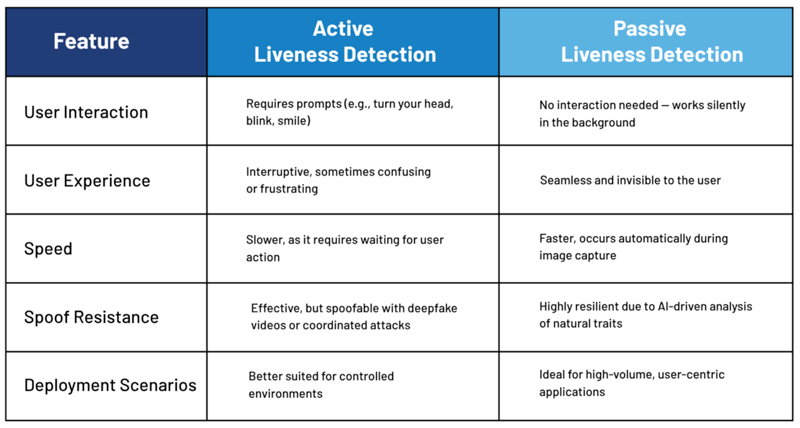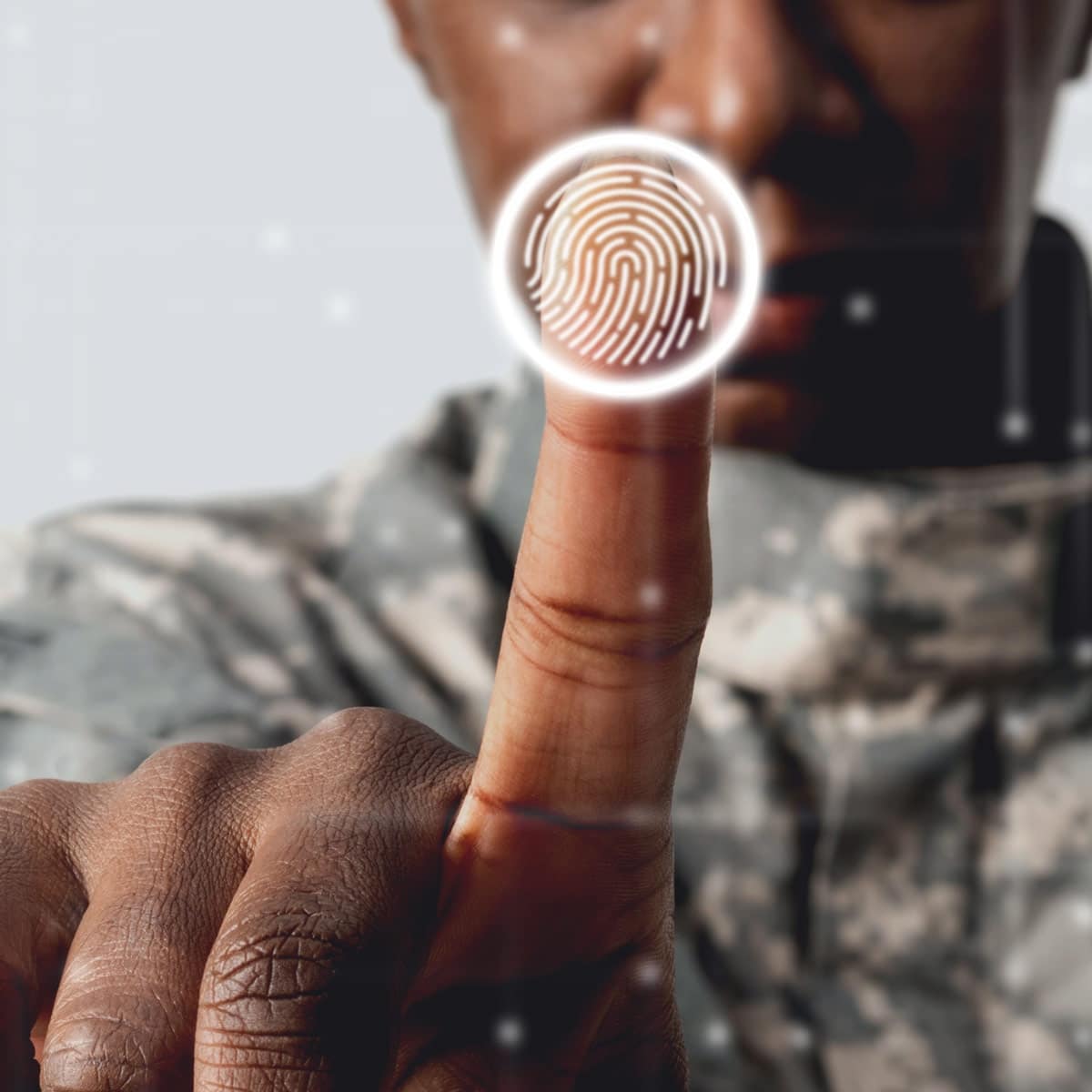With the explosion of online interactions and increasing sophistication of fraudsters, the need for strong, user-friendly biometric authentication has never been greater.
One of the technologies leading the way is passive liveness detection, a behind-the-scenes innovation that silently distinguishes real users from spoofing attacks. But what exactly is it? And why is it becoming the preferred choice over older, more intrusive methods?
What Is Passive Liveness Detection and Why Is It Important?
Liveness detection is a security technique used in biometric systems to determine whether the person interacting with the system is a live human being rather than a false representation, like a high-quality photo, video, mask, or other presentation-type attack.
Passive liveness detection does this without requiring any active participation from the user. It quietly analyzes a selfie or video frame to look for subtle signs of life, like natural skin texture, light reflections, or involuntary facial micro-movements, using advanced machine learning and computer vision.
This technology is important because attackers have become increasingly skilled at spoofing, aka tricking, biometric systems. Deepfakes, 3D masks, and high-resolution printed photos can easily fool traditional systems if liveness detection is absent or weak. Passive liveness provides a crucial layer of defense — without disrupting the user experience.
What’s the Difference Between Active and Passive Liveness Detection?
While both passive and active methods aim to detect signs of life, they do so in very different ways:

What Are the Benefits of Passive Liveness Versus Active Liveness?
Passive liveness detection offers several compelling advantages that make it a superior choice in many use cases:
1. Frictionless User Experience
In an era where digital convenience is king, passive liveness allows organizations to verify users without slowing them down. There’s no need for instructions or retries — users just take a selfie, and the system does the rest. This improves completion rates and reduces drop-off during enrollment or logins.
2. Higher Accuracy Against Sophisticated Threats
Passive systems analyze a broader range of biometric and environmental cues, including light patterns, depth information, and texture analysis, that are hard for even advanced spoofing methods to mimic. This makes them more robust in the face of deepfakes, replay attacks, and high-quality printed spoofs.
3. Scalable and Flexible
Passive liveness detection is easier to deploy in diverse environments, whether it’s a crowded airport, a poorly lit room, or a busy e-commerce platform. It even works well using standard smartphones or webcams, making it ideal for remote identity verification at scale.
4. Better Accessibility
Because it requires no specific movement or voice commands, passive liveness is more inclusive. It works for people with limited mobility or neurodivergent users who may find interactive prompts difficult.
Where Is Passive Liveness Making an Impact?
Passive liveness detection is transforming identity verification across a wide range of industries, offering the perfect blend of strong security, seamless experience, and fraud prevention. Here’s how it’s making a tangible difference in key sectors:
Banking & Fintech
Use Case: Onboarding new customers remotely, authorizing high-value transactions, and enabling secure account recovery.
Benefits:
- Frictionless Enrollment: Customers can open accounts or apply for loans from their phones in under a minute with passive liveness running silently behind the scenes to confirm they’re real.
- Reduced Abandonment: No confusing prompts or selfie retries means more completed sign-ups and fewer dropped applications.
- Fraud Defense: Banks can flag and block synthetic identities and deepfake attempts before they ever reach the system.
Healthcare
Use Case: Verifying patient identity during telehealth appointments, prescription refills, and access to health records.
Benefits:
- Privacy-Compliant Verification: Ensures only the authorized patient is accessing sensitive data or services, helping providers stay HIPAA-compliant.
- Convenient for Patients: No need for in-person visits or physical documents. Patients can authenticate with a simple selfie from their device.
- Telehealth Enablement: Passive liveness protects against identity fraud in virtual care environments, preserving trust between doctors and patients.
Workforce & Time Management
Use Case: Authenticating employees clocking in or accessing sensitive systems, particularly in remote or contract work environments.
Benefits:
- Prevents Time Fraud: Confirms that the right employee is clocking in and not a buddy or manipulated system.
- Remote Readiness: Enables flexible and hybrid workforces with secure identity assurance, even offsite or in the field.
- Reduced Admin Overhead: Cuts down on manual verification processes, freeing up HR and operations teams.
Gig Economy & Peer-to-Peer Platforms
Use Case: Verifying both users and service providers on platforms like Uber, DoorDash, Airbnb, and TaskRabbit.
Benefits:
- Trusted Ecosystems: Ensures the person driving the car, delivering your food, or staying in your home is who they claim to be.
- Ongoing Reverification: Passive liveness allows platforms to recheck identity periodically or during high-risk activities (e.g., large payments or host payouts) without disrupting service.
- Fraud Reduction: Helps prevent identity sharing or fake accounts, boosting safety and trust for both parties.
Border Security & Immigration
Use Case: Verifying travelers at immigration checkpoints, e-gates, and visa application centers.
Benefits:
- Faster Throughput: Travelers can be verified in seconds at automated border control kiosks without needing to perform gestures.
- Enhanced Security: Passive liveness blocks spoofing attempts using photos, deepfakes, or masks at border crossings.
- Support for Contactless Travel: Promotes hygiene and efficiency in busy transit hubs, especially important post-pandemic.
Travel & Hospitality
Use Case: Remote identity verification for online check-ins, hotel reservations, or loyalty program access.
Benefits:
- Seamless Check-In: Guests can verify identity before arrival, skip the front desk, and go straight to their rooms.
- Guest Confidence: Assures travelers that hosts, drivers, or co-passengers have also been verified, reducing fraud or impersonation risks.
- Global Scalability: Works across borders, devices, and lighting conditions — perfect for mobile-savvy travelers.
The Future of Security and Convenience
Passive liveness detection marks a new frontier in digital identity, one where security doesn’t have to come at the cost of experience. As fraud tactics grow more sophisticated, so must the defenses we deploy.
By integrating passive liveness into biometric authentication, businesses can offer stronger protection and faster verification — a true win-win for security and usability.
Interested in using passive liveness detection to secure and scale your business?
Aware is a DHS RIVTD validated provider of passive liveness detection technology, and we’ve been trusted for over 30 years to deliver advanced biometric solutions to organizations and agencies around the globe. Get in touch with us if you’re ready to explore more about the power of biometrics for your business.



